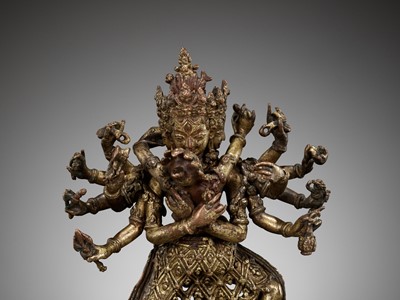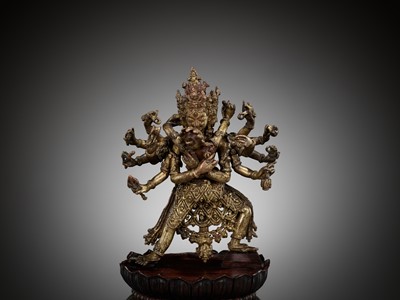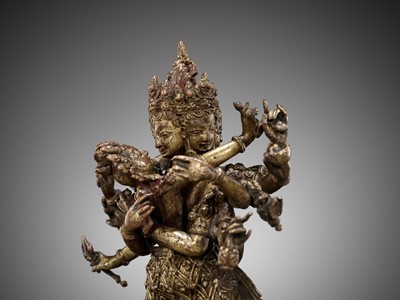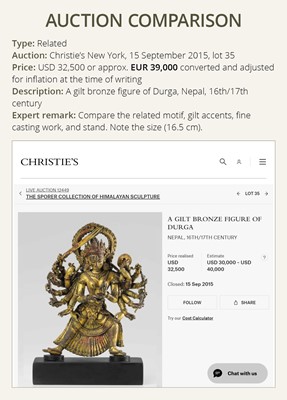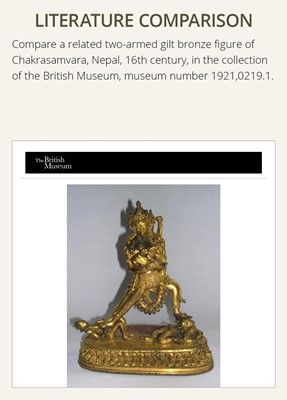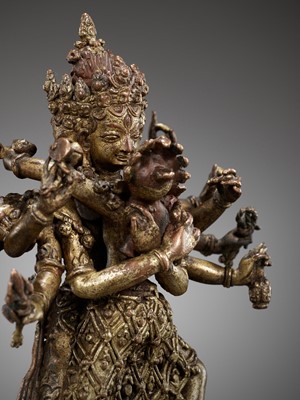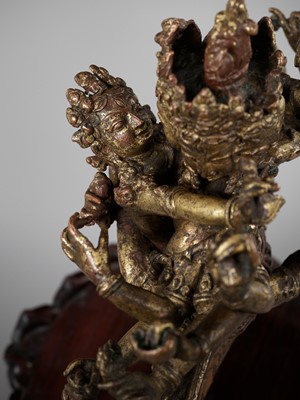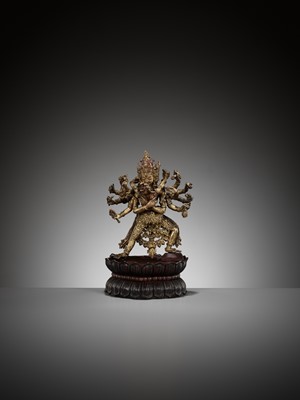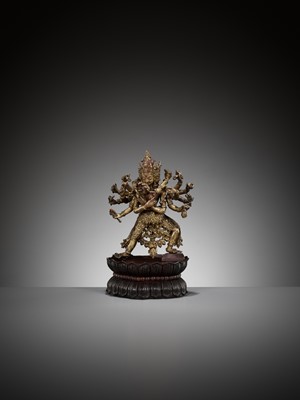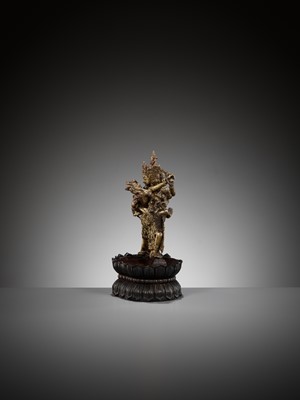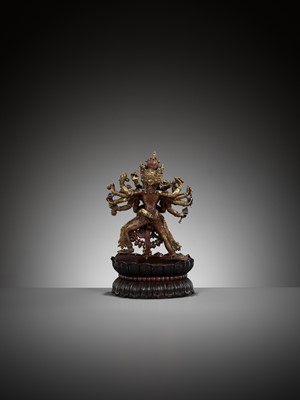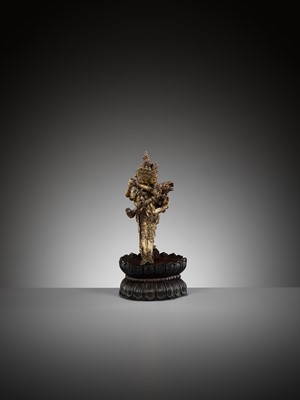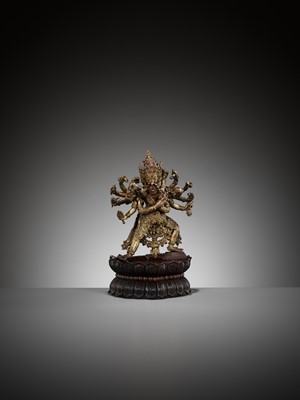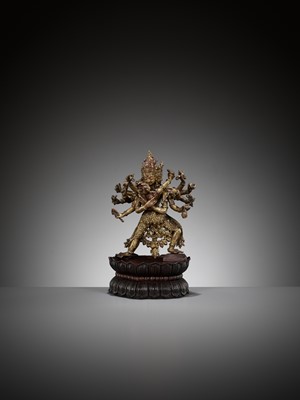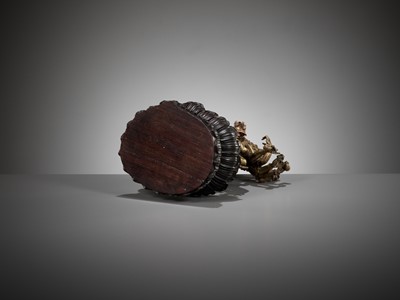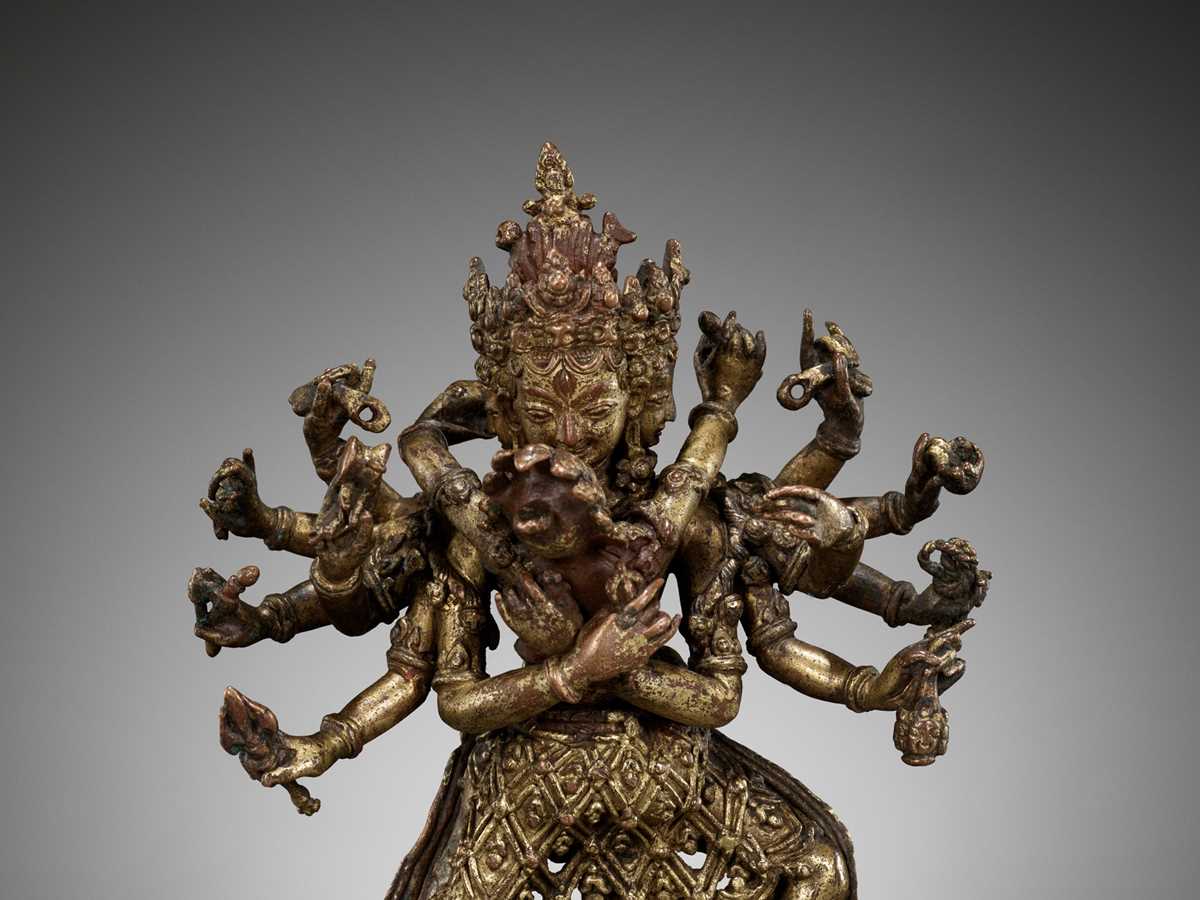9th Mar, 2023 13:00
TWO-DAY AUCTION - Fine Chinese Art / 中國藝術集珍 / Buddhism & Hinduism
173
A GILT BRONZE FIGURE OF CHAKRASAMVARA, LATE MALLA, THREE KINGDOMS PERIOD
馬拉王朝末年,三國時期,銅鎏金勝樂金剛像
Sold for €7,800
including Buyer's Premium
Nepal, 1520-1768. Striding in alidhasana with his consort Vajravarahi in yab-yum, the four-headed deity surmounted by a skull crown, his primary hands embracing his consort and holding a vajra and ghanta, the other ten hands holding attributes including damaru, kapala, kartika, and katvanga, dressed in a beaded loincloth, his legs flanked by two billowing scarfs, Vajravarahi wearing an elaborate skirt with skull pendant. Their faces finely incised with gently arched eyebrows centered by an urna, with almond shaped eyes, and a subtle smile.
Provenance: British trade.
Condition: Very good condition with expected old wear to the gilt, minimal losses, minor casting flaws, and few small malachite encrustations. The stand with few chips to the edges and natural age cracks.
Weight: 1,269 g (incl. stand)
Dimensions: Height 20.4 cm (incl stand)
With a fitted hardwood base, probably Zitan, finely carved as a double lotus throne. (2)
The Three Kingdoms period - the time of the later Mallas - began in 1520 and lasted until the mid-eighteenth century. The complete flowering of the unique culture of the Kathmandu Valley occurred during this period, and it was also during this time that the old palace complexes in the three main towns achieved much of their present-day forms. The kings still based their legitimate rule on their role as protectors of dharma, and often they were devout donors to religious shrines. Kings built many of the older temples in the valley, gems of late medieval art and architecture, during this final Malla period. The present figure seems to be rather early in the period, e.g., 16th to mid-17th century.
The vision of Twelve-armed Samvara in an ecstatic, dance-like embrace with his consort Vajravarahi is one of the most exquisite subjects in Vajrayana Buddhist art. Meaning ‘Wheel of Bliss’ in Sanskrit, the union of the two deities is known as Chakrasamvara, as represented in this near-complete example. The deities embody the attainment of the highest yoga tantra tradition and Tibetan Buddhism's supreme ideal: the skilled union of perfect wisdom (Vajravarahi) and compassion (Samvara).
Being so complex, only the very best artists were fit to undertake the challenge of casting Chakrasamvara. The task most often fell to Newari master craftsmen from Nepal who produced such sculptures for domestic and Tibetan worship. The stylistic preferences of each audience are somewhat slightly different. While many contemporaneous Tibetan examples emphasize the ferociousness of Chakrasamvara's facial expressions, here instead, a benign intimacy is shared between the deities gazing into each other's eyes. The sentiment betrays a preference in Nepal for showing divine couples in harmony, as representatives of ideal matrimony.
Literature comparison:
Compare a related two-armed gilt bronze figure of Chakrasamvara, Nepal, 16th century, in the collection of the British Museum, museum number 1921,0219.1.
Auction result comparison:
Type: Related
Auction: Christie’s New York, 15 September 2015, lot 35
Price: USD 32,500 or approx. EUR 39,000 converted and adjusted for inflation at the time of writing
Description: A gilt bronze figure of Durga, Nepal, 16th/17th century
Expert remark: Compare the related motif, gilt accents, fine casting work, and stand. Note the size (16.5 cm).
馬拉王朝末年,三國時期,銅鎏金勝樂金剛像
尼泊爾,1520-1768年。勝樂金剛勝四頭,十二臂,兩足,弓步。主尊頭戴五葉冠,上有太陽和新月符。主臂兩手分別持金剛杵和金剛鈴,另外兩手擁抱明妃金剛亥母。其餘各手分別持不同的法器,如三叉戟、匕首、卡巴拉碗等。脖子上掛人首做成的項鍊,雙足奮力踩踏兩個魔鬼,威力無比。金剛亥母雙腿盤在勝樂金剛腰間,,穿著花飾腰帶,佩戴著珠飾。金剛及其明妃面容表情細緻入微,眉毛微彎,微笑。
來源:英國古玩交易。
品相:狀況極好,鎏金有磨損,小缺損,輕微鑄造缺陷,少量孔雀石色結殼。底座邊緣輕微碎屑和自然老化裂縫。
重量:1,269 克 (含底座)
尺寸:高20.4 厘米 (含底座)
硬木底座,可能爲紫檀,精美雕刻雙層蓮座。 (2)
尼泊爾三國時期,即馬拉王朝末年——始於 1520 年,一直持續到十八世紀中葉。加德滿都谷地獨特文化的全面發展就在這一時期,也是在這一時期,三個主要城鎮的舊宮殿建築群形成了今天的大致規模。國王們的合法統治仍然基於他們作為佛法保護者的角色,而且他們經常是宗教聖地的虔誠捐助者。在馬拉王朝末年,國王們在山谷中建造了許多古老的寺廟,這些寺廟是中世紀晚期藝術和建築的瑰寶。目前這件造像可能來自十六世紀至十七世紀中葉。
十二臂勝樂金剛與他的明妃金剛亥母雙修是金剛乘佛教藝術中最精美的題材之一。本造像體現了最高瑜伽密宗傳統和藏傳佛教最高理想的成就:圓滿智慧 (Vajravarahi) 與慈悲 (Samvara) 的巧妙結合。
雖然許多同時代的西藏造像都強調勝樂金剛的忿怒相,但在這裡,本尊彼此注視著彼此的眼睛,卻表現出一種溫和的親密感。這種情緒脫離了尼泊爾的一種偏好,即把神聖的夫妻和諧相處,作為理想婚姻的代表。
文獻比較:
比較相近的十六世紀尼泊爾雙臂銅鎏金勝樂金剛像 ,收藏於大英博物館,館藏編號1921,0219.1。
拍賣結果比較:
形制:相近
拍賣:紐約佳士得,2015年9月15日,lot 35
價格:USD 32,500(相當於今日EUR 39,000)
描述:十六/十七世紀尼泊爾銅鎏金難近母像
專家評論:比較相近的主題、鎏金裝飾、精美鑄造和底座。請注意尺寸 (16.5 厘米)。
Nepal, 1520-1768. Striding in alidhasana with his consort Vajravarahi in yab-yum, the four-headed deity surmounted by a skull crown, his primary hands embracing his consort and holding a vajra and ghanta, the other ten hands holding attributes including damaru, kapala, kartika, and katvanga, dressed in a beaded loincloth, his legs flanked by two billowing scarfs, Vajravarahi wearing an elaborate skirt with skull pendant. Their faces finely incised with gently arched eyebrows centered by an urna, with almond shaped eyes, and a subtle smile.
Provenance: British trade.
Condition: Very good condition with expected old wear to the gilt, minimal losses, minor casting flaws, and few small malachite encrustations. The stand with few chips to the edges and natural age cracks.
Weight: 1,269 g (incl. stand)
Dimensions: Height 20.4 cm (incl stand)
With a fitted hardwood base, probably Zitan, finely carved as a double lotus throne. (2)
The Three Kingdoms period - the time of the later Mallas - began in 1520 and lasted until the mid-eighteenth century. The complete flowering of the unique culture of the Kathmandu Valley occurred during this period, and it was also during this time that the old palace complexes in the three main towns achieved much of their present-day forms. The kings still based their legitimate rule on their role as protectors of dharma, and often they were devout donors to religious shrines. Kings built many of the older temples in the valley, gems of late medieval art and architecture, during this final Malla period. The present figure seems to be rather early in the period, e.g., 16th to mid-17th century.
The vision of Twelve-armed Samvara in an ecstatic, dance-like embrace with his consort Vajravarahi is one of the most exquisite subjects in Vajrayana Buddhist art. Meaning ‘Wheel of Bliss’ in Sanskrit, the union of the two deities is known as Chakrasamvara, as represented in this near-complete example. The deities embody the attainment of the highest yoga tantra tradition and Tibetan Buddhism's supreme ideal: the skilled union of perfect wisdom (Vajravarahi) and compassion (Samvara).
Being so complex, only the very best artists were fit to undertake the challenge of casting Chakrasamvara. The task most often fell to Newari master craftsmen from Nepal who produced such sculptures for domestic and Tibetan worship. The stylistic preferences of each audience are somewhat slightly different. While many contemporaneous Tibetan examples emphasize the ferociousness of Chakrasamvara's facial expressions, here instead, a benign intimacy is shared between the deities gazing into each other's eyes. The sentiment betrays a preference in Nepal for showing divine couples in harmony, as representatives of ideal matrimony.
Literature comparison:
Compare a related two-armed gilt bronze figure of Chakrasamvara, Nepal, 16th century, in the collection of the British Museum, museum number 1921,0219.1.
Auction result comparison:
Type: Related
Auction: Christie’s New York, 15 September 2015, lot 35
Price: USD 32,500 or approx. EUR 39,000 converted and adjusted for inflation at the time of writing
Description: A gilt bronze figure of Durga, Nepal, 16th/17th century
Expert remark: Compare the related motif, gilt accents, fine casting work, and stand. Note the size (16.5 cm).
馬拉王朝末年,三國時期,銅鎏金勝樂金剛像
尼泊爾,1520-1768年。勝樂金剛勝四頭,十二臂,兩足,弓步。主尊頭戴五葉冠,上有太陽和新月符。主臂兩手分別持金剛杵和金剛鈴,另外兩手擁抱明妃金剛亥母。其餘各手分別持不同的法器,如三叉戟、匕首、卡巴拉碗等。脖子上掛人首做成的項鍊,雙足奮力踩踏兩個魔鬼,威力無比。金剛亥母雙腿盤在勝樂金剛腰間,,穿著花飾腰帶,佩戴著珠飾。金剛及其明妃面容表情細緻入微,眉毛微彎,微笑。
來源:英國古玩交易。
品相:狀況極好,鎏金有磨損,小缺損,輕微鑄造缺陷,少量孔雀石色結殼。底座邊緣輕微碎屑和自然老化裂縫。
重量:1,269 克 (含底座)
尺寸:高20.4 厘米 (含底座)
硬木底座,可能爲紫檀,精美雕刻雙層蓮座。 (2)
尼泊爾三國時期,即馬拉王朝末年——始於 1520 年,一直持續到十八世紀中葉。加德滿都谷地獨特文化的全面發展就在這一時期,也是在這一時期,三個主要城鎮的舊宮殿建築群形成了今天的大致規模。國王們的合法統治仍然基於他們作為佛法保護者的角色,而且他們經常是宗教聖地的虔誠捐助者。在馬拉王朝末年,國王們在山谷中建造了許多古老的寺廟,這些寺廟是中世紀晚期藝術和建築的瑰寶。目前這件造像可能來自十六世紀至十七世紀中葉。
十二臂勝樂金剛與他的明妃金剛亥母雙修是金剛乘佛教藝術中最精美的題材之一。本造像體現了最高瑜伽密宗傳統和藏傳佛教最高理想的成就:圓滿智慧 (Vajravarahi) 與慈悲 (Samvara) 的巧妙結合。
雖然許多同時代的西藏造像都強調勝樂金剛的忿怒相,但在這裡,本尊彼此注視著彼此的眼睛,卻表現出一種溫和的親密感。這種情緒脫離了尼泊爾的一種偏好,即把神聖的夫妻和諧相處,作為理想婚姻的代表。
文獻比較:
比較相近的十六世紀尼泊爾雙臂銅鎏金勝樂金剛像 ,收藏於大英博物館,館藏編號1921,0219.1。
拍賣結果比較:
形制:相近
拍賣:紐約佳士得,2015年9月15日,lot 35
價格:USD 32,500(相當於今日EUR 39,000)
描述:十六/十七世紀尼泊爾銅鎏金難近母像
專家評論:比較相近的主題、鎏金裝飾、精美鑄造和底座。請注意尺寸 (16.5 厘米)。
Zacke Live Online Bidding
Our online bidding platform makes it easier than ever to bid in our auctions! When you bid through our website, you can take advantage of our premium buyer's terms without incurring any additional online bidding surcharges.
To bid live online, you'll need to create an online account. Once your account is created and your identity is verified, you can register to bid in an auction up to 12 hours before the auction begins.
Intended Spend and Bid Limits
When you register to bid in an online auction, you will need to share your intended maximum spending budget for the auction. We will then review your intended spend and set a bid limit for you. Once you have pre-registered for a live online auction, you can see your intended spend and bid limit by going to 'Account Settings' and clicking on 'Live Bidding Registrations'.
Your bid limit will be the maximum amount you can bid during the auction. Your bid limit is for the hammer price and is not affected by the buyer’s premium and VAT. For example, if you have a bid limit of €1,000 and place two winning bids for €300 and €200, then you will only be able to bid €500 for the rest of the auction. If you try to place a bid that is higher than €500, you will not be able to do so.
Online Absentee and Telephone Bids
You can now leave absentee and telephone bids on our website!
Absentee Bidding
Once you've created an account and your identity is verified, you can leave your absentee bid directly on the lot page. We will contact you when your bids have been confirmed.
Telephone Bidding
Once you've created an account and your identity is verified, you can leave telephone bids online. We will contact you when your bids have been confirmed.
Classic Absentee and Telephone Bidding Form
You can still submit absentee and telephone bids by email or fax if you prefer. Simply fill out the Absentee Bidding/Telephone bidding form and return it to us by email at office@zacke.at or by fax at +43 (1) 532 04 52 20. You can download the PDF from our Upcoming Auctions page.
How-To Guides
How to Create Your Personal Zacke Account
How to Register to Bid on Zacke Live
How to Leave Absentee Bids Online
How to Leave Telephone Bids Online
中文版本的操作指南
创建新账号
注册Zacke Live在线直播竞拍(免平台费)
缺席投标和电话投标
Third-Party Bidding
We partner with best-in-class third-party partners to make it easy for you to bid online in the channel of your choice. Please note that if you bid with one of our third-party online partners, then there will be a live bidding surcharge on top of your final purchase price. You can find all of our fees here. Here's a full list of our third-party partners:
- 51 Bid Live
- EpaiLive
- ArtFoxLive
- Invaluable
- LiveAuctioneers
- the-saleroom
- lot-tissimo
- Drouot
Please note that we place different auctions on different platforms. For example, in general, we only place Chinese art auctions on 51 Bid Live.
Bidding in Person
You must register to bid in person and will be assigned a paddle at the auction. Please contact us at office@zacke.at or +43 (1) 532 04 52 for the latest local health and safety guidelines.
